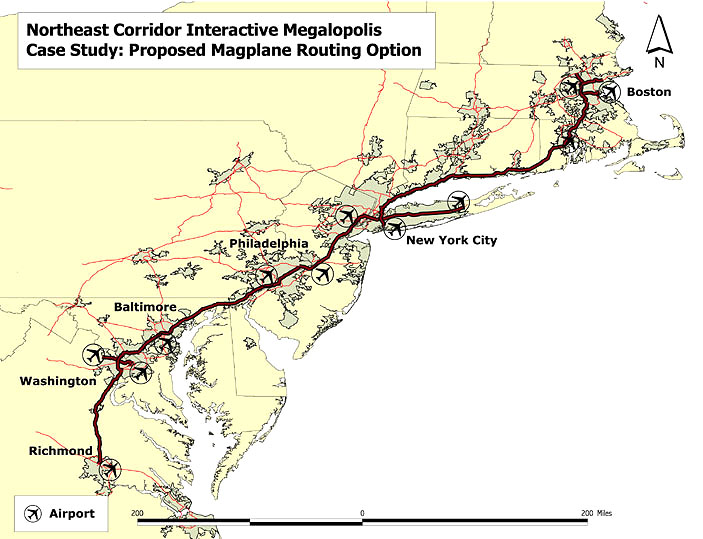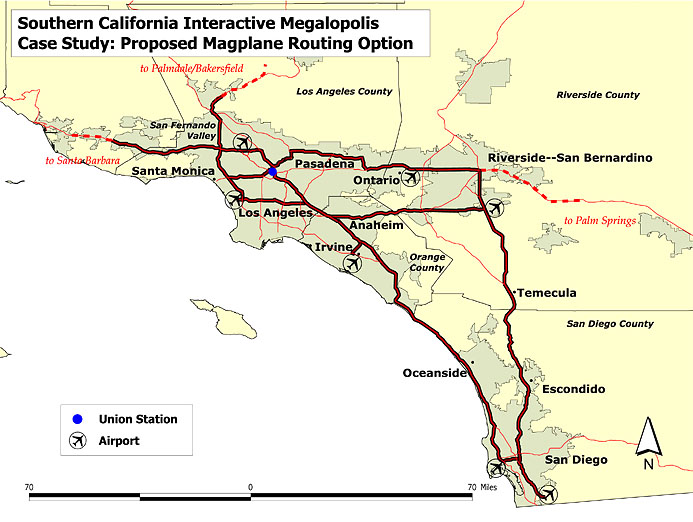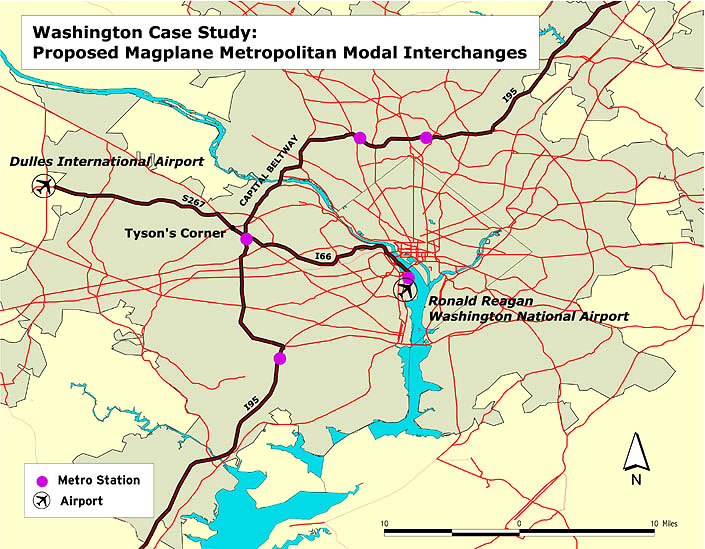USA MARKET
NORTHEAST CORRIDOR
Four decades after Jean Gottmann described the US Northeast Corridor as a Megalopolis, the Magplane Commuting Service can consolidate this vast urban region into an interdependent and integrated urban system, allowing workers to live in one metropolitan region while working in another.
The map shows the proposed alignment and the link above, the estimated trip times for travel between the five major metropolitan regions of this corridor: Boston, New York City, Philadelphia, Baltimore-Washington, and Richmond.
Short travel times and affordable, convenient, and reliable service can emulate the service characteristics of commuter rail in the days prior to freeways.
The expansion of the knowledge based labor pool for Boston's Route 128, for example, to include workers resident in New York City, and Providence, Rhode Island will enhance labor productivity substantially. And Boston's knowledge intensive industries will become more globally competitive, attracting more investment and knowledge workers into the Northeast corridor. As knowledge labor becomes more specialized, the interdependence of the metropolitan regions in this corridor will grow, ushering in the Interactive Megalopolis.
With the arrival of the "Virtual Workplace," daily commutes may not become necessary for many of these workers. However the ability to transport a worker 400 km with the utmost reliability, speed, convenience, and economy to meet with clients and coworkers, will influence the ability of companies to recruit and locate workers in adjacent metropolitan regions, or points in between. Magplane can accelerate the development of a "Virtual Workplace" for the American labor force.

SOUTHERN CALIFORNIA INTERACTIVE MEGALOPOLIS
A flexible Magplane Service in Southern California would follow the rights of way of the principal interstates to provide a high degree of mobility for commuters. Most trip times within the Interactive Megalopolis would be less than 30 minutes, even for commuters between Los Angeles and San Diego. These commuting times will match the travel times of subway systems in metropolitan areas but differ in one key respect: speed and range beyond the commuting distance for the automobile.
Intermodal service would be provided to airports, automobile parking facilities, the subways in Los Angeles and other convenient transfer points. This illustrative routing below demonstrates the ability of the Magplane system to serve multiple destinations using off-line stations.
Extensions to other important Southern California points, including Santa Barbara, Lancaster/Palmdale, Palm Springs, and even Tijuana, at the Mexican border are also possible with the Magplane system.

SOUTHERN CALIFORNIA MAGPLANE AIRPORT CONNECTIONS
Airport connections represent an important intermodal connection opportunity for The Magplane. While the capacity of the existing Southern California Region Commercial Airport System is approximately 100 million annual passengers, it is projected that this system will experience a passenger capacity shortfall of one-third by 2020. To meet this rising demand, airport facilities will have to be expanded. In Southern California, where fierce local public opposition is preventing the expansion of Los Angeles International Airport and the relocation of flights to adjacent airports such as John Wayne International or El Toro, The Magplane system enables airport planners to convert distant military bases to civilian use.
Magplane can link the following airports into a single airport network allowing passengers to interconnect to other airports without clearing security, if necessary. In this fashion, The Magplane would become an extension of the taxiways. At 400 km, Los Angeles International Airport connecting passengers would be able to connect to adjoining airports within a half hour or less, roughly the time it takes for the 15th aircraft waiting in line for a congested runway to take off. The strategic location of underutilized March Air Force Base and Palmdale Airport to congested Los Angeles International Airport, San Diego Lindbergh Field, and John Wayne International make available alternative airport options that would be environmentally, economically, and politically, more sustainable. Similar airport capacity problems are occurring across the country.

PROPOSED MAGPLANE INTERMODAL INTERCHANGES

The maps above depict a Case Study of Proposed Magplane Intermodal Interchanges for Boston and Greater Washington D.C.
The ease of locating off-line stations at strategic passenger distribution systems, be it airports, freeways, subway lines, and even large regional shopping centers, enables the Magplane to distribute boardings and alightings over a wide geographic area and to minimize magport access and egress times.
This flexibility is an important operational feature of the Magplane since most commuters no longer travel from the suburbs to the downtown area. Over half of the nation's commuters reside in the suburbs and 44% of all commuters begin and end their trip in a suburb. The traditional suburb to downtown commute, now represents only 20% of the commuting market.
Like a subway system, the Magplane commuting service would offer passengers many choices of station stops. But because the Magplane service operates with single vehicles rather than coupled rail or subway cars, commuters can bypass these off-line stations until reaching their ultimate destination. Transfer stations would provide passengers with high frequency service from low density markets.
Magplane Technology allows for a very flexible means to locate stations whether during the initial construction, or after a system has been built. The technology enables urban regions to access the Magplane system in response to rising travel demand or to rapidly changing land development patterns.

THE NEW URBAN TRANSPORTATION REQUIREMENT
Commuters worldwide resist traveling over an hour to work or to a business meeting. No existing conventional transportation system technology can significantly reduce the commuting time for people working and interacting in megalopolitan clusters, whether in the US Northeast Corridor, Southern California, or even Paris-London.
The commuting range of the automobile is limited to about 30 to 100 km, depending on traffic conditions. Air transport, even popular and cost effective regional commuters, is still costly and vulnerable to airport delays and ground access problems. High Speed Rail suffers from high operating costs, is prone to station access limitations, and is capacity constrained. Therefore none of these transportation modes are able to transform a Boston - New York intercity trip into an equivalent intracity commuting trip as defined by cost (less than a cab ride), time (door to door in less than 60 minutes), capacity (subway), and a high degree of convenience.
An alternative transportation system is required in the New Economy, one that is faster and longer reaching than a car, subway or other public transit, and more convenient, affordable, reliable, and accessible than an airplane. In short, a new transportation system is needed for the new emerging transportation market of the 21st Century.
The Magplane Solutions:
The Magplane system is best able to provide intercity commuting ranges at intracity commuting times, fares, capacity levels and convenience. Magplane offers off-line stations, elevated lightweight guideways, superior speed, capacity, safety, reliability and maintainability, in an environmentally sustainable manner. Magplane elevated guideways and off-line stations can more readily be superimposed onto existing urban and regional communities than any other high speed transport means.
The Magplane system has been conceived to meet the transportation needs of the new information age. A Magplane system, operating at speeds of 400 km/h and with a station access and egress time of 45 minutes, could cover about 320 km in one and a half hours. Therefore, the prime market for Magplane service is one that current transportation systems cannot serve: commuting distances greater than 60 to 120 km depending on traffic conditions, but less than 320 km. In this process, the benefits for our metropolitan populations and our existing transportation systems can be enormous.